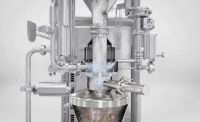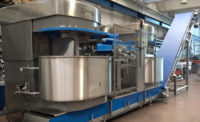New dough mixers bring operational benefits to snack and bakery facilities
Mixer updates improve upon speed, durability, food safety, easy CIP and more










Snack food and bakery facilities have a long list of requests for manufacturers of mixers, including improved speed, efficiency, throughput, durability, food safety, batch uniformity and labor reduction, as well as the flexibility to easily switch out recipes and easily perform cleaning and sanitation tasks.
Customers of Erika Record, Clifton, NJ, ask about speed, efficiency, batches per shift and cutting down on batch times, says Aaron Sweet, sales consultant. Durability is another concern. “Every customer’s needs are different,” he says. “They want it to integrate smoothly with what they already have.”
Shaffer mixers, produced by Bundy Baking Solutions, Urbana, OH, most frequently fields requests for greater food safety and labor reduction, says Andrew McGhie, director of sales. And then greater throughput, especially for customers in Europe and Asia, who tend to want horizontal rather than vertical mixers.
Customers of Koenig Bakery Systems, Ashland, VA, seem most concerned about timing of their mixes, says Richard Breeswine, CEO. The company has customers who are concerned about mixing their doughs for too long, such as for ciabatta doughs with high dough yield, he says. “We consult customers nowadays often about mixing their doughs properly so the best results are attained.”
Zeppelin Systems USA, Odessa, FL, hears most often from customers who want equipment that provides greater flexibility to change recipes and allow for easy clean-in-place (CIP), says Joe Cross, process manager. This allows them to spend less time on daily processes with equipment and changeovers, he says. “In addition to that, we’re seeing greater interest all the time in driving down the energy costs to make products.”
Cross also notes that a growing number of customers want process and technological support from their equipment partners. “This has facilitated the development of technology centers among equipment providers, and Zeppelin has already been in the forefront of this trend, having opened a technology center many years ago to support proof-of-concept trials and production verification for the food industry.”
Customers of Charles Ross & Son Co., Hauppauge, NY, ask about batch-to-batch uniformity and ability to clean easily, according to Ken Langhorn, technical director. “People aren’t so much concerned about the quality of the equipment,” he says. “They assume that’s going to be there. It’s more so those little, subtle areas—the fine-tuning of the process.”
Mixer customers looking for greater efficiencies need to keep in mind several factors, says Ed Fay, president, CMC America Corp., Joliet, IL. These include energy efficiency, the cost of personnel, the reliability and repeatability from one batch to the next, and the time commitment per batch, which necessarily varies from one type of dough to the next due to different absorption rates, he says.
Customers also need to keep in mind their needs in terms of temperature control, flexibility in design to be able to do quick changeovers among different SKUs, and the ability to meet regulatory requirements with regard to cleaning—which vary between the U.S. and abroad, although the FDA has been more aggressively inspecting plants around the world that export to the U.S., bringing greater uniformity, Fay says. “International companies are finding that onerous, and U.S. companies are rejoicing.”
New and improved
Erika Record offers a line of spiral mixers from LP Group that include the VIS-R fixed bowl, LUX-R removable bowl, LYNX-R self-tilting bowl, ARES-R side-tilting bowl lift and THOR-R overhead bowl lift. All have been designed with the American market in mind, capable of processing stiff doughs with lower hydration levels, and the range of models offers customization options.
The company has upgraded the first three (VIS-R, LUX-R and LYNX-R) to include a built-in bowl drain for easier cleaning and sanitation, and all three of those offer belt drive train and reinforced dual motors with one dedicated to turning the bowl and the other to driving the attachment. The latter two (ARES-R and THOR-R) are designed for use in conjunction with LUX-R bowls and offer the ability to choose discharge heights.
Erika Record also offers planetary mixers: the MX Series from Mecnosud, the Ergo model from Varimixer, and the industrial vertical planetary, bridge-shaped mixers from Tonelli. The latter range from 120 to 600 quarts and are pressurized to cut down on mixing time, Sweet says. The Tonelli also has an option for a self-contained auto-wash system that helps speed along the process while maintaining safety standards, he notes. The Mecnosud and Varimixer models provide controls at eye level for ergonomic reasons.
Shaffer has rolled out a new line called the Select Series targeted at the world market that includes Single Sigma Arm and Triple Roller Bar mixers. The batch sizes are suitable for small to medium-sized operators—between about 600 and 1,000 pounds—with a sanitary open-frame design and simplified mechanical design for easier maintenance, reducing lead times and cost, McGhie says. “We tried to simplify the design, taking the costs out, reducing the number of options and making it more standard.”
The company has refined CIP technologies to include integrated solutions that speed up sanitation cycles and product changeover, using high-pressure spray heads, retained bowl hardware that allows quick change of bowl seals, and rotary face agitator shaft seals that enable quick cleaning or replacement—and limit the potential for cross-contamination. “You get better cleaning and use less water and detergents,” McGhie says. “CIP is a big piece of what we’re offering, with quick changeover, cleaning the mixer in place rather than a big shutdown.”
Shaffer also has been looking to automate wherever possible, especially given tighter labor markets and the ever-greater pressure to employ fewer people, McGhie says. “It’s a big opportunity—time to invest the money but get a payback.” Mixers routinely interface with handling systems upstream and product makeup equipment downstream, optimizing the process. They can automatically add ingredients in stages during the production process and then discharge doughs to the chunkers and dough-handling equipment.
Koenig has launched the Twin Twist Mixer DW 240 in a newly hygienic design, model 240-H, which the company says meets the higher international customer requirements for cleaning and maintenance. The 240-H offers wash-down capability from end to end with low-pressure water, a completely sealed and welded frame and machine head, stainless steel construction, and easily accessible coverings for cleaning and maintenance. The 240-H is especially suitable for wheat and pastry doughs, and the mixer does well with rye and rye wheat, as well, with dough hydrations to 80 percent.
The Fireking Baking Co., Braintree, MA, has installed a DW 240-H to help with bread and bun doughs, and Hudson Bread in New Jersey also employs one for its brioche and hamburger doughs, as well as bread and ciabatta, Breeswine says.
Zeppelin Systems offers the CODOS continuous dough mixing system and the Dymo Mix hydration unit that mixes flour and water, or flour and a water-yeast mixture. The CODOS provides consistency of temperature leading to better forming and baking, the need for less manpower and a higher efficiency per pound of dough produced, Cross says. In addition, Zeppelin has upgraded several of the system’s components, including bearings and seal assemblies, to bring about an even more-hygienic design.
The Dymo Mix also has been upgraded during the past year or so, with an easier-to-disassemble design for quicker cleaning. The machine comes in a jacketed version for greater temperature control, which is of particular importance if the baker wants to mix oil and sugar and needs the oil to stay liquid as it disperses, Cross says.
“What we typically see when we use the Dymo Mix to pre-hydrate flour is an increase in dough yield of anywhere from 1 to 3 percent,” says Cross. “If your standard recipe is to take 100 pounds of flour and add 62 pounds of water, with Dymo Mix you might be able to add 64 or 65 pounds of water to get the same consistency. Ultimately, the baker is getting more yield out of the final product at no extra charge, just the cost of the water.”
One additional benefit: when using the Dymo Mix as a prehydration tool, it typically reduces batch mixing times by up to 30 percent. “You don’t have to spend that time and energy putting the bowls together,” Cross says.
CMC America Corp. offers Batch Quality Control systems for mixers that provide the ability to monitor temperature throughout the process, for example, so that a bakery knows at the front end of the process that a given batch is three degrees colder than the last one, Fay says. “You can note and define a problem, so you can fix it before you have ruined dough.”
CMC also has Glycol Cooling systems for mixer bowls that currently feature a “dramatically improved” jacketing system, Fay says. “The new jacket designs are highly turbulent, more so than in the past, with a dramatically lower pressure drop, so their heat transfer capability is much higher. When you try to extract heat energy out of a dough, you need turbulent dough, without being too aggressive.”
For more on new mixer technology and equipment, see “Exclusive Q&A—mixer multitasking with Rapidojet.”
Looking for a reprint of this article?
From high-res PDFs to custom plaques, order your copy today!











